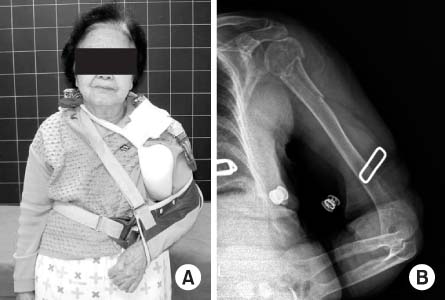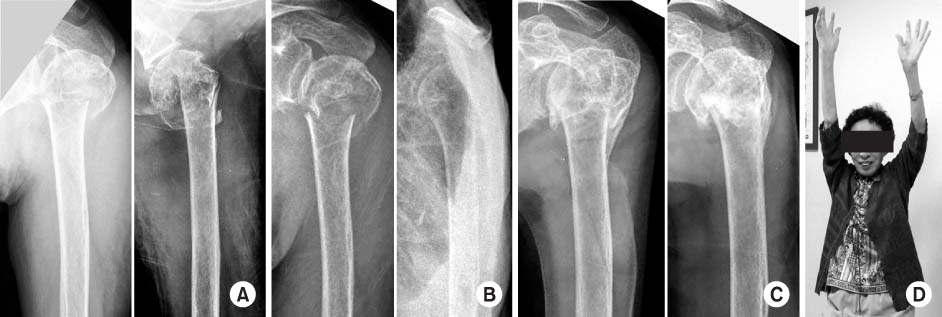Articles
- Page Path
- HOME > J Musculoskelet Trauma > Volume 26(4); 2013 > Article
-
Original Article
- The Result of Conservative Treatment of Proximal Humerus Fracture in Elderly Patients
- Seung-Gil Baek, M.D., Chang-Wug Oh, M.D., Ph.D., Young-Soo Byun, M.D., Ph.D., Jong-Keon Oh, M.D., Ph.D., Joon-Woo Kim, M.D., Ph.D., Jong-Pil Yoon, M.D., Hyun-Joo Lee, M.D., Hyung-Sub Kim, M.D.
-
Journal of the Korean Fracture Society 2013;26(4):292-298.
DOI: https://doi.org/10.12671/jkfs.2013.26.4.292
Published online: October 18, 2013
Department of Orthopedic Surgery, Kyungpook National University School of Medicine, Daegu, Korea.
*Department of Orthopedic Surgery, Daegu Fatima Hospital, Daegu, Korea.
†Department of Orthopedic Surgery, Korea University College of Medicine, Seoul, Korea.
- Address reprint requests to: Chang-Wug Oh, M.D., Ph.D. Department of Orthopedic Surgery, Kyungpook National University Hospital, 130 Dongdeok-ro Jung-gu, Deagu 700-721, Korea. Tel: 82-53-420-5630, Fax: 82-53-422-6605, cwoh@knu.ac.kr
• Received: May 31, 2013 • Revised: July 16, 2013 • Accepted: August 20, 2013
Copyright © 2013 The Korean Fracture Society. All rights reserved.
This is an Open Access article distributed under the terms of the Creative Commons Attribution Non-Commercial License (http://creativecommons.org/licenses/by-nc/3.0/) which permits unrestricted non-commercial use, distribution, and reproduction in any medium, provided the original work is properly cited.
- 475 Views
- 4 Download
Abstract
-
Purpose
- With the increase in the old age population, proximal humerus fractures have been increasing recently. However, complications after operative treatment, such as fixation failure, are common because of osteoporosis. We treated proximal humerus fractures in patients with osteoporosis conservatively, and evaluated the radiographic and functional results by analyzing the factors affecting the results.
-
Materials and Methods
- Nineteen out of 30 cases for whom the clinical follow-up was over 1 year were included in this retrospective study. There were 17 females and 2 males, and the mean age was 73.2 years. The causes were slip from a short height (18 cases) and a minor car accident (1 case). We evaluated the union period, nonunion, malunion and the Constant score and analyzed several factors affecting the functional result, such as age, fracture pattern, and malunion.
-
Results
- Seventeen cases (89.5%) obtained union within 12.8 weeks on average. Neck-shaft angle was 125.3° on average, with seven cases of malunion. The Constant score was 84.1 on average, and there were excellent scores in 11 cases, good scores in 4 cases, and fair scores in 2 cases. Fracture pattern, neck-shaft angle, or malunion did not affect the functional outcome, and elderly patients showed poorer shoulder function.
-
Conclusion
- Proximal humeral fractures with osteoporosis may achieve a high rate of bony union when treated with conservative methods. Despite the common occurrence of malunion, a satisfactory functional outcome may be expected.
- 1. Badman BL, Mighell M. Fixed-angle locked plating of two-, three-, and four-part proximal humerus fractures. J Am Acad Orthop Surg, 2008;16:294-302.Article
- 2. Bell JE, Leung BC, Spratt KF, et al. Trends and variation in incidence, surgical treatment, and repeat surgery of proximal humeral fractures in the elderly. J Bone Joint Surg Am, 2011;93:121-131.Article
- 3. Court-Brown CM, Garg A, McQueen MM. The translated two-part fracture of the proximal humerus. Epidemiology and outcome in the older patient. J Bone Joint Surg Br, 2001;83:799-804.
- 4. Fjalestad T, Hole MØ, Hovden IA, Blücher J, Strømsøe K. Surgical treatment with an angular stable plate for complex displaced proximal humeral fractures in elderly patients: a randomized controlled trial. J Orthop Trauma, 2012;26:98-106.Article
- 5. Iyengar JJ, Devcic Z, Sproul RC, Feeley BT. Nonoperative treatment of proximal humerus fractures: a systematic review. J Orthop Trauma, 2011;25:612-617.Article
- 6. Konrad G, Audigé L, Lambert S, Hertel R, Südkamp NP. Similar outcomes for nail versus plate fixation of three-part proximal humeral fractures. Clin Orthop Relat Res, 2012;470:602-609.Article
- 7. Lam F, Mok D. Open repair of massive rotator cuff tears in patients aged sixty-five years or over: is it worthwhile? J Shoulder Elbow Surg, 2004;13:517-521.Article
- 8. Lind T, Krøner K, Jensen J. The epidemiology of fractures of the proximal humerus. Arch Orthop Trauma Surg, 1989;108:285-287.ArticlePDF
- 9. Min WK, Sin SJ, Jeon IH, et al. Fixation failure of LCP during the treatment of proximal humerus fractures. J Korean Fract Soc, 2006;19:188-192.Article
- 10. Nho SJ, Brophy RH, Barker JU, Cornell CN, Mac-Gillivray JD. Innovations in the management of displaced proximal humerus fractures. J Am Acad Orthop Surg, 2007;15:12-26.Article
- 11. Oh JH, Kim YH. The current concepts in the treatment of proximal humerus fracture. J Korean Fract Soc, 2012;25:94-104.Article
- 12. Okike K, Lee OC, Makanji H, Harris MB, Vrahas MS. Factors associated with the decision for operative versus non-operative treatment of displaced proximal humerus fractures in the elderly. Injury, 2013;44:448-455.Article
- 13. Robinson CM, Amin AK, Godley KC, Murray IR, White TO. Modern perspectives of open reduction and plate fixation of proximal humerus fractures. J Orthop Trauma, 2011;25:618-629.Article
- 14. Solberg BD, Moon CN, Franco DP, Paiement GD. Locked plating of 3- and 4-part proximal humerus fractures in older patients: the effect of initial fracture pattern on outcome. J Orthop Trauma, 2009;23:113-119.Article
- 15. Sproul RC, Iyengar JJ, Devcic Z, Feeley BT. A systematic review of locking plate fixation of proximal humerus fractures. Injury, 2011;42:408-413.
- 16. Südkamp N, Bayer J, Hepp P, et al. Open reduction and internal fixation of proximal humeral fractures with use of the locking proximal humerus plate. Results of a prospective, multicenter, observational study. J Bone Joint Surg Am, 2009;91:1320-1328.
- 17. Torrens C, Corrales M, Vilà G, Santana F, Càceres E. Functional and quality-of-life results of displaced and nondisplaced proximal humeral fractures treated conservatively. J Orthop Trauma, 2011;25:581-587.Article
- 18. van den Broek CM, van den Besselaar M, Coenen JM, Vegt PA. Displaced proximal humeral fractures: intramedullary nailing versus conservative treatment. Arch Orthop Trauma Surg, 2007;127:459-463.ArticlePDF
- 19. Voigt C, Geisler A, Hepp P, Schulz AP, Lill H. Are polyaxially locked screws advantageous in the plate osteosynthesis of proximal humeral fractures in the elderly? A prospective randomized clinical observational study. J Orthop Trauma, 2011;25:596-602.Article
- 20. Withrow PM, Stoecker JL, Stevens K, Clark K. Nonoperative management of a patient with a two-part minimally displaced proximal humerus fracture: a case report. Physiother Theory Pract, 2010;26:120-133.Article
- 21. Yüksel HY, Yimaz S, Akşahin E, Celebi L, Muratli HH, Biçimoğlu A. The results of nonoperative treatment for three- and four-part fractures of the proximal humerus in low-demand patients. J Orthop Trauma, 2011;25:588-595.Article
REFERENCES
Fig. 1
(A) An 80-year-old female using a shoulder immobilizer with an appropriate axillary pad.
(B) An antero-posterior radiograph shows well-maintained reduction of the fracture during use of a shoulder immobilizer with axillary pad.


Fig. 2
(A) A 78-year-old female with a displaced proximal humerus fracture (AO/OTA 11-A2).
(B) Satisfactory reduction was achieved.
(C) After 16 weeks, bony union was obtained, with acceptable alignment.
(D) At 1 year, the patient had almost full recovery of her shoulder movements with a Constant score of 93 points.


Figure & Data
REFERENCES
Citations
Citations to this article as recorded by 

The Result of Conservative Treatment of Proximal Humerus Fracture in Elderly Patients



Fig. 1
(A) An 80-year-old female using a shoulder immobilizer with an appropriate axillary pad.
(B) An antero-posterior radiograph shows well-maintained reduction of the fracture during use of a shoulder immobilizer with axillary pad.
Fig. 2
(A) A 78-year-old female with a displaced proximal humerus fracture (AO/OTA 11-A2).
(B) Satisfactory reduction was achieved.
(C) After 16 weeks, bony union was obtained, with acceptable alignment.
(D) At 1 year, the patient had almost full recovery of her shoulder movements with a Constant score of 93 points.
Fig. 3
(A) An 84-year-old female sustained a proximal humerus fracture (AO/OTA 11-A2).
(B) Reduction was achieved.
(C) At 12 weeks, bony union was obtained, with varus deformity.
(D) At 4 years, the patient showed a good functional outcome with mildly limited movements of the shoulder.
Fig. 1
Fig. 2
Fig. 3
The Result of Conservative Treatment of Proximal Humerus Fracture in Elderly Patients
Summary of Cases
Table 1
Summary of Cases

 E-submission
E-submission KOTA
KOTA TOTA
TOTA TOTS
TOTS


 Cite
Cite

